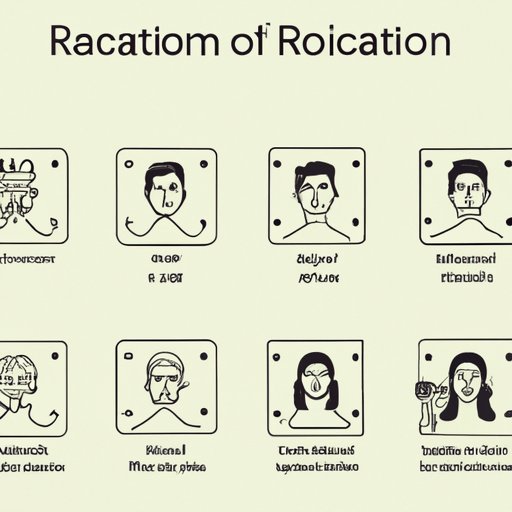Introduction
Facial recognition technology has been around for decades, but today it is becoming increasingly popular with advancements in computer vision and artificial intelligence. But what exactly is facial recognition, and when was it first invented? This article will explore the history of facial recognition and trace its development from inception to modern day.

A History of Facial Recognition: From Inception to Modern Day
Facial recognition is a biometric technology that uses an individual’s facial features to identify them. The technology uses algorithms to detect and measure facial features such as eyes, nose, mouth, and chin, which are then compared against stored data to recognize the person. Facial recognition technology has come a long way since its initial conception, with continual improvements in accuracy and speed.
The use of facial recognition technology dates back to the 1960s when Woodrow Bledsoe developed a system to recognize human faces using a computer. Since then, facial recognition technology has advanced significantly, with improved algorithms and faster processors allowing for more accurate identification. Today, facial recognition technology is used in a variety of applications, from security and surveillance to retail and banking.
How Facial Recognition Technology Has Evolved Over Time
Facial recognition technology has gone through several iterations over the years, with different approaches being taken to improve accuracy and speed. In the past, facial recognition systems relied on 2D images, which were limited in their ability to accurately identify individuals due to changes in lighting and angle. However, advances in 3D imaging have enabled more accurate facial recognition, with higher resolution images resulting in better performance.
Along with 3D imaging, facial recognition technology has also benefited from advances in machine learning and artificial intelligence. Machine learning algorithms can be trained to recognize facial features, while AI-based facial recognition systems are able to analyze large datasets and identify patterns in order to accurately identify individuals.
Today, facial recognition technology is used in a variety of applications, from security and surveillance to retail and banking. It is also increasingly being used in social media platforms, allowing users to quickly and easily tag friends in photos and videos.
The Evolution of Facial Recognition: Tracing Its Origins
In order to understand the evolution of facial recognition technology, it is important to trace its origins back to the early experiments with facial recognition. One of the earliest experiments with facial recognition was conducted by Woodrow Bledsoe, who developed a computer-based system to recognize human faces in the 1960s. This early experiment laid the groundwork for future developments in facial recognition technology.
Since then, there have been numerous key milestones in facial recognition history, including the development of the first facial recognition software in the 1970s and the emergence of deep learning algorithms in the 2000s. Each of these milestones has played an important role in the development of facial recognition technology and has helped to shape the technology into what it is today.
The impact of facial recognition on modern society cannot be overstated. From security and surveillance to retail and banking, facial recognition technology is being used in a variety of industries to improve efficiency and accuracy. As facial recognition technology continues to evolve, its applications are likely to become even more widespread.

Exploring the Timeline of Facial Recognition Invention
So when was facial recognition first invented? While the exact date of facial recognition invention is difficult to pinpoint, it is generally accepted that the technology was first developed by Woodrow Bledsoe in the 1960s. This early experiment laid the foundation for future developments in facial recognition technology, with subsequent milestones occurring in the 1970s, 1980s, and 1990s.
Some of the major milestones in facial recognition invention include the development of the first facial recognition software in the 1970s, the emergence of deep learning algorithms in the 2000s, and the introduction of high-resolution cameras in the 2010s. Each of these milestones has played an important role in the development of facial recognition technology, paving the way for the technology to become more accurate, efficient, and reliable.
The development of facial recognition algorithms has also had a significant impact on the evolution of facial recognition technology. By leveraging machine learning and artificial intelligence, facial recognition algorithms have been able to provide more accurate and reliable results than ever before.

From Concept to Creation: The Invention of Facial Recognition Technology
To understand the invention of facial recognition technology, it is important to consider the concept behind it. Facial recognition technology relies on the use of algorithms to detect and measure facial features, which are then compared against stored data to identify individuals. This process requires hardware and software components, both of which have undergone significant advancements over the years.
The development of facial recognition hardware has been crucial to the advancement of facial recognition technology. High-resolution cameras allow for more accurate image capture, while infrared sensors enable facial recognition in low-light conditions. Advances in computer processing power have also helped to improve the accuracy and speed of facial recognition systems.
In addition to hardware advancements, the development of facial recognition software has also been key to the success of facial recognition technology. Algorithms such as deep learning are able to analyze large datasets and identify patterns in order to accurately identify individuals, while AI-based facial recognition systems are able to make decisions in real-time.
Conclusion
Facial recognition technology is one of the most revolutionary technologies of our time, with applications ranging from security and surveillance to retail and banking. Tracing its origins back to the 1960s, facial recognition technology has come a long way since its initial conception, with continual improvements in accuracy and speed. From early experiments to modern day applications, the invention of facial recognition technology has had a profound impact on society.
(Note: Is this article not meeting your expectations? Do you have knowledge or insights to share? Unlock new opportunities and expand your reach by joining our authors team. Click Registration to join us and share your expertise with our readers.)
